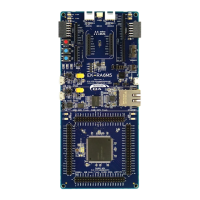Renesas RA Family EK-RA6M5 v1 – User's Manual
R20UT4829EG0100 Rev. 1.00 Page 16 of 34
Mar.15.21
5.2 Debug and Trace
The EK-RA6M5 board supports the following three debug modes.
Table 2. Debug Modes
(one that
connects to the
(one that is being
debugged)
Interface/Protocol
debugging tools
20-pin connector (J20)
or 10-pin connector (J13)
MCU
Micro USB (J10) plus either
20-pin connector (J20)
or 10-pin connector (J13)
Notes:
• See Table 4 for the Debug USB connector pin definition.
• See Table 7 for the 20-pin JTAG connector pin definition.
• See Table 8 for the 10-pin JTAG connector pin definition.
The following table summarizes the jumper setting for each of the debug modes.
Table 3. Jumper Connection Summary for Different Debug Modes
Jumpers on pins
1-2, 3-4, 5-6, 7-8
Jumpers on pins
1-2, 3-4, 5-6, 7-8
5.2.1 Debug On-Board
The on-board debug functionality is provided using Renesas S124 Debug MCU and SEGGER J-Link
®
firmware. Debug USB Micro-B connector (J10) connects the S124 Debug MCU to an external USB Full
Speed Host, allowing re-programming and debugging of the target RA MCU firmware. This connection is the
default debug mode for the EK-RA6M5 board.
The S124 Debug MCU connects to the target RA MCU using the SWD interface.
Table 4. Debug USB Connector
USB ID, jack internal switch, cable inserted
A yellow indicator, LED5, shows the visual status of the debug interface. When the EK-RA6M5 board is
powered on, and LED5 is blinking, it indicates that the S124 Debug MCU is not connected to a programming
host. When LED5 is on solid, it indicates that the S124 Debug MCU is connected to a programming
interface.

